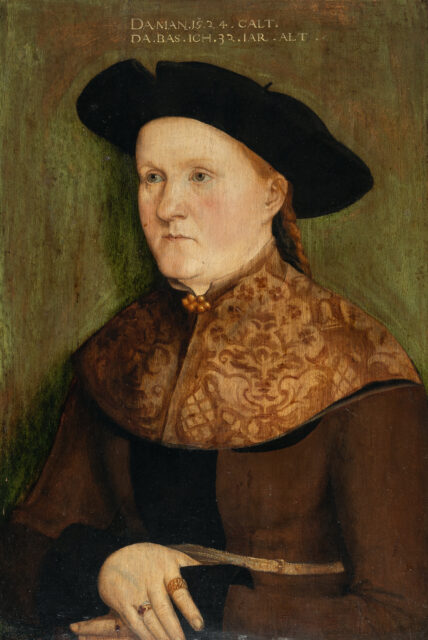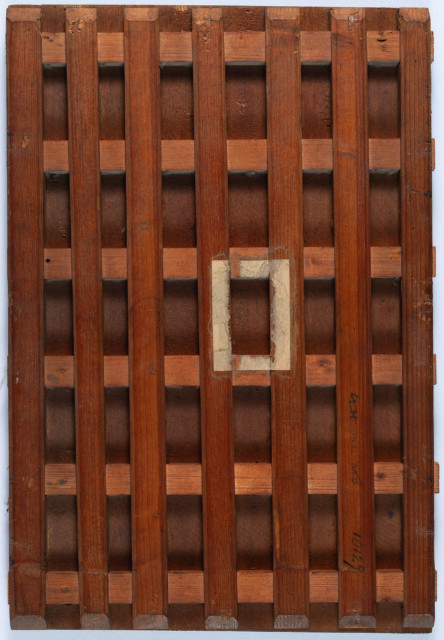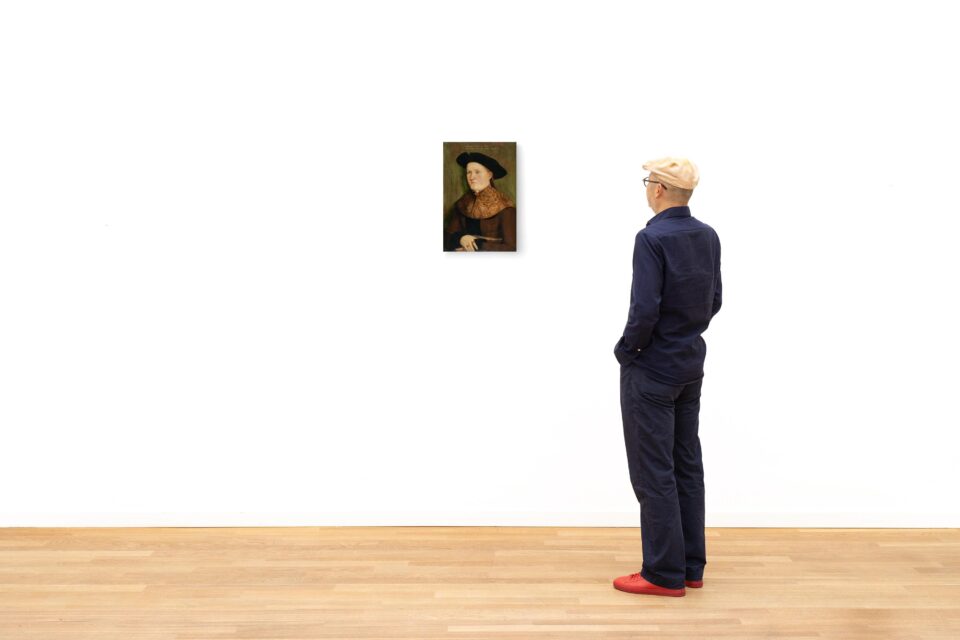Portrait of a 32 year old woman (“Dorothea Jörg”)
Details
Löcher 75.
Literatur:
Ludwig Baldass: Studien zur Augsburger Porträtmalerei des 16. Jahrhunderts. Teil II: Bildnisse von Leonhard Beck, in: Pantheon 6, 1930, S. 396, Nr. 8;
Kurt Löcher: Nürnberger Bildnisse nach 1520, in: Kunstgeschichtliche Studien für Kurt Bauch zum 70. Geburtstag von seinen Schülern, München 1967, S. 122; Ders.: Ein Bildnis der Anna Dürer in der Sammlung Thyssen-Bornemisza, in: Wallraf-Richartz-Jahrbuch 39, 1977, S. 88, Abb. 5;
Peter Strieder: Tafelmalerei in Nürnberg 1350-1550, Königstein im Taunus 1993, S. 281, Nr. 165, Abb. (Barthel Beham zugeschrieben);
Kurt Löcher: Barthel Beham, in: Saur. Allgemeines Künstlerlexikon, Bd. 8, München 1994, S. 288;
Ders.: Barthel Beham. Ein Maler aus dem Dürerkreis, München-Berlin 1999, S. 66, Abb. 66, und S. 217, Nr. 75 (unter fragliche Zuschreibungen);
Sebastian Schmidt: Abbild – Selbstbild. Das Porträt in Nürnberg um 1500, Wiesbaden 2018, S. 344-345, Nr. 81, Abb. (Barthel Beham?).
Ausstellung:
Meister um Albrecht Dürer, Ausst.-Kat. Germanisches Nationalmuseum, Nürnberg 1961, S. 64, Nr. 30.
Provenienz:
Benediktinerstift Lambach, Oberösterreich; Galerie Sanct Lucas, Wien;
Kunsthandel Julius Böhler, München (seit 1936, zwischenzeitlich ins Ausweichlager Penk, Oberpfalz (?) ausgelagert);
Kunsthandel Paul de Boer, Amsterdam (1954-1957); Kunsthandel Julius Böhler, München, 1962 verkauft an Fritz Mailänder (1897-1984), Fürth;
Privatbesitz, Süddeutschland.
Description
In the painting, the painter presents the bust of a middle-aged woman facing left against a greenish background with little pictorial differentiation. She is wearing a beret as a headdress and a goller closed with a brooch over her brown dress – a damask shoulder collar with a pomegranate pattern covering her shirt. The portrait bears the inscription “DA. MAN. 15.2.4. CALT. DA. BAS. ICH. 32. IAR. OLD”. In 1524, when the painting was painted according to the inscription, the sitter was 32 years old. A later inscription referred to the woman as Dorothea Jörg, but this designation can no longer be verified on the painting.
She has placed her ringed right hand on her left forearm, which not only gives the portrait a closed compositional effect, but also lends it a certain seriousness and rigour, which is also expressed in the woman’s face. Her incarnation is warm, with slightly rosy cheeks and a rather introverted gaze past the viewer towards an imaginary counterpart, which Kurt Löcher was able to identify on the basis of the corresponding inscription in a male portrait by Barthel Beham in the Picture Gallery in Prague (Prague, National Gallery, inv. no. O 720). The painter attached great importance to clearly emphasising the profile, behind which the slightly shadowed half of her face recedes. The simple portrait demonstrates a good, lively power of observation in an overall finely tuned colour scheme, which is, however, without any great intrinsic colouristic value. The painting’s strengths lie above all in the drawing, with the precisely observed face and hands emerging from the background.
Known to art historians for almost a hundred years, Ludwig Baldass first attributed the portrait to a group of male portraits in 1930, which he had attributed to Leonhard Beck from Augsburg, even though Baldass noted that the portrait was “a little coarser” in expression than the other portraits. However, the localisation to Augsburg is contradicted by the fashionable appearance of the woman, as the beret and goller point to Nuremberg, where the bonnet was replaced by the fashionable beret around this time. The shape of the beret varied, but always remained the same in the type of flaps meeting above the crown and connected by a button and loop. It was widespread around 1525, as can be seen in Dürer’s portrait of Veronika Formschneider from 1525 (London, British Museum, inv. no. 5218.50), and the Goller can also be found on various portraits of the time in Nuremberg.
Max J. Friedländer and Ernst Buchner recognised the portrait as an early work by Barthel Beham, created in Nuremberg, in independent expert opinions that are no longer available today. Beham is best known for the fact that he, together with his brother Sebald and Jörg Pencz, was one of the “three godless painters” in Nuremberg who had joined the radical wing of the Reformation before its introduction, for which they were banished from their hometown in 1525 for heresy. Barthel Beham returned after a short time, but only stayed for a short time before entering the service of Duke Wilhelm IV in Munich as court painter in 1527. As a painter, he belonged to the wider Dürer school, but there is no confirmed painting from his Nuremberg years. Kurt Löcher, the author of the catalogue raisonné of Beham’s paintings, has only included our portrait among the questionable attributions, but it is so close to certain paintings by Beham, such as the Portrait of a Young Man (formerly Bremen, Kunsthalle, inv. no. 169-1851), that its authorship can be considered established. Certain uncertainties, such as the somewhat formulaic composition, can be conceded to a beginner, who Beham, born in 1502, still was in 1524.
Dr Peter Prange
We would like to thank Dr Birgit Jooss, head of the project “Kunsthandlung Julius Böhler”, Zentralinstitut für Kunstgeschichte, Munich, for information on the provenance.
* All results incl. buyer’s premium (27%) without VAT. No guarantee, subject to error.
** All post-auction prices excl. buyer's premium and VAT. No guarantee, subject to error.
*** Conditional Sale: The bid was accepted below the limit. Acquisition of the work may still be possible in our post-auction sale.
R = regular taxation
N = differential taxation on works of art which originate from a country outside of the EU
The private or commercial use of images shown on this Website, in particular through duplication or dissemination, is not permitted. All rights reserved.





